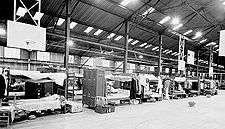Tin Can (basketball arena)
Coordinates: 35°54′33″N 79°2′49″W / 35.90917°N 79.04694°W
 The Tin Can in 1946 | |
| Location | South Road, Chapel Hill, N.C., United States (demolished) [1] |
|---|---|
| Owner | University of North Carolina at Chapel Hill [1] |
| Capacity | N/A |
| Field size | 300 × 110 feet (91 × 34 m) [2] |
| Construction | |
| Broke ground | 1921 [1] |
| Opened | 1924 [1] |
| Closed | 1938 [2] |
| Demolished | 1977 [1] |
| Construction cost | $54,482.45 [3] |
| Architect | Bard-Knox Company, Pittsburgh, Pa., United States [2] |
| Tenants | |
| North Carolina Tar Heels (NCAA) 1924-38 [2] | |
Officially named the Indoor Athletic Center (or Court), the Tin Can was the home of North Carolina Tar Heels men's basketball from the 1924 season until the team's relocation to the Woollen Gymnasium in 1938.[4][5] It replaced Bynum Gymnasium, a venue known for its unusual running track suspended above the court.[6]
Rudimentarily built of steel, attempts to heat the building during early season at first failed, with ice often forming inside:
| “ | The Tin Can was always freezing [...] they had icicles in the corners. To stay warm the electricians put those big-wattage bulbs under the benches, and we had blankets and wore heavy sweat clothes. Later on they did get central heat in there, but it was never adequate. You couldn't dress there. | ” | |
| — George Shephard, North Carolina coach 1931-35, University of North Carolina Basketball | |||
The team, known as the White Phantoms, used this to their advantage, becoming one of the South's most successful programs by the mid-1920s.[7]
As success continued into Southern Conference play in the 1930s, the capacity of the Tin Can proved insufficient to meet the increased interest in the team. North Carolina played the last of their games there at the end of the 1938 season, having officially moved to the adjacent Woollen Gymnasium on January 4, 1938.[8] In fourteen years, the team had accumulated a 120–38 winning record.[9]
No longer needed for major athletic events the Tin Can was used for a variety of purposes during the remainder of its life. Immediately after World War II, the arena housed returning veterans due to a shortage of dormitory space,[10] while in the early 1950s it was used for storage of medical equipment before the completion of North Carolina Memorial Hospital.[11] After hosting a limited number of indoor track meetings in preceding years, the Tin Can was finally demolished in 1977 to allow the construction of the present day Fetzer Gymnasium.[12]
Notes
- 1 2 3 4 5 UNC EIS, Main incl. Stats.
- 1 2 3 4 UNC EIS, Alias & Notes 1923–38
- ↑ UNC EIS, Alias & Notes 1921–29.
- ↑ Powell, pp. 16.
- ↑ Rappoport, pp. 17.
- ↑ Powell, pp. 15.
- ↑ Powell, pp. 17.
- ↑ Powell, pp. 29.
- ↑ Powell, pp. 24.
- ↑ UNC EIS, Alias & Notes 1944–48.
- ↑ UNC EIS, Alias & Notes 1949–52.
- ↑ UNC EIS, Alias & Notes 1952/77.
References
- "Building 154". Plan Room. UNC Engineering Information Services (EIS). Retrieved 2008-06-21.
- Powell, Adam (2005). University of North Carolina Basketball. Mount Pleasant, S.C.: Arcadia Publishing. ISBN 0-7385-4150-8.
- Rappoport, Ken (2005). Tales from the Tar Heel Locker Room (Second ed.). Champaign, Ill.: Sports Publishing. ISBN 1-59670-006-8.
